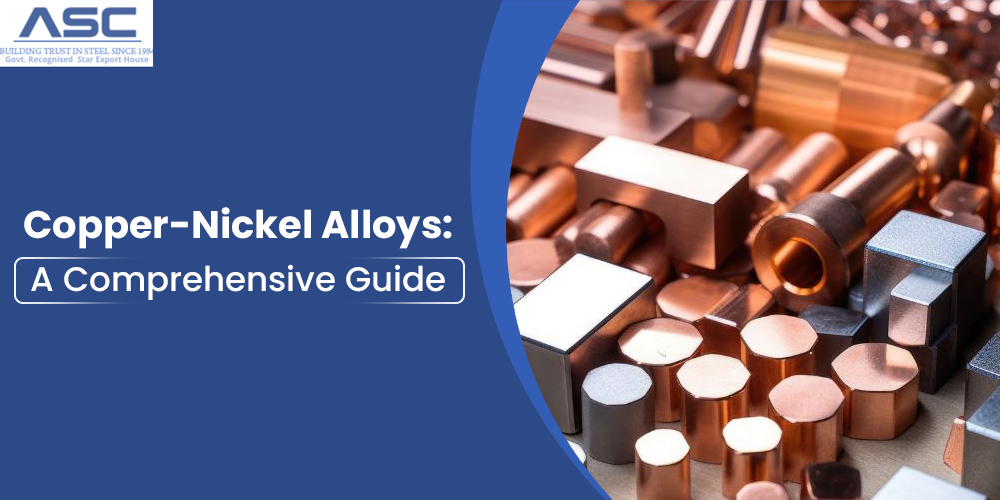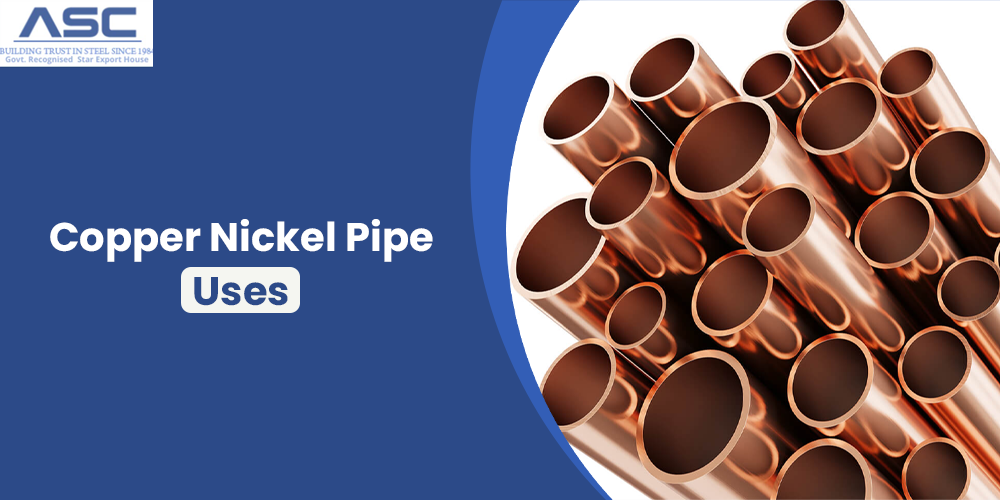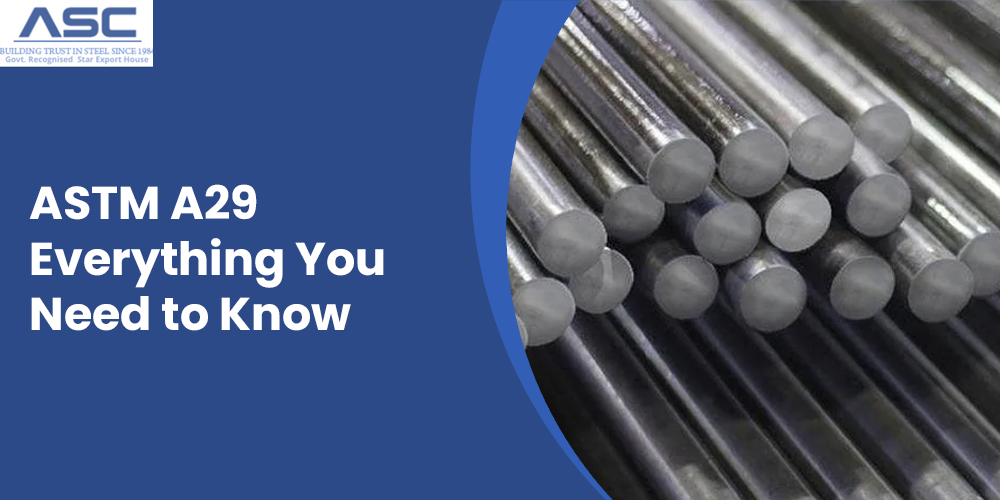Copper Nickel Pipe Sizes & Applications
by AMC
Posted on September 10, 2024 at 12:40 PM

Copper-nickel pipes are popular in many industries because they are strong, durable, and corrosion-resistant. They also have excellent welding properties, making them a great choice for various projects. However, before buying copper-nickel pipes for your needs, it is important to understand the different sizes available. This guide will help you explore the various sizes of copper-nickel tubing in the market to make the best decision for your project.
What is Copper Nickel Pipe?
Copper-nickel (Cu-Ni) pipes are used to connect systems that handle seawater. These pipeline systems include copper-nickel pipes, fittings, flanges, and valves. Two common copper-nickel alloys used in these systems are 90-10 Cu-Ni (90% copper, 10% nickel) and 70-30 Cu-Ni (70% copper, 30% nickel). These alloys are popular because they resist corrosion and biofouling, are strong, and are cost-effective to produce.
Copper Nickel 90/10 is often used in submarines due to its strength. For other applications, the 70-30 Cu-Ni ratio is commonly used.
While there are many materials available, the trend is to use 90-10 Cu-Ni over other alloys like aluminum, brass, or stainless steel for several reasons:
- Strength and Weldability - Cu-Ni alloys are strong and easy to weld.
- Corrosion Resistance - They resist corrosion well under stress and don’t usually need extra treatments after manufacturing.
- Proven Reliability - Cu-Ni alloys have a strong track record, with only a few cases of early failure reported over the last 20 years.
Check Out Our Related Blog on - What Is Copper-Nickel Pipe Used For?
Factors to Consider When Selecting Copper Nickel Pipe Sizes
Copper-nickel pipes are available in various sizes to meet industrial needs, particularly in marine and seawater handling systems. These pipes typically range from 1/8 inch to 24 inches in outer diameter (OD), providing options for both small and large-scale applications. The wall thickness of copper-nickel pipes is often specified by a schedule number, such as Sch 10, Sch 40, or Sch 80, which indicates the pipe's thickness and pressure rating. Thicker pipes, like those with a higher schedule number, are designed to handle higher pressure levels.
Copper-nickel pipes are usually supplied in standard lengths of 6 meters (20 feet) or 12 meters (40 feet), but they can be customized to specific lengths as required by the project. They are available in both seamless and welded types, where seamless pipes are preferred for high-pressure environments due to their strength, and welded pipes are more cost-effective for lower-pressure applications.
Copper-nickel alloy pipes are valued for their strong seawater corrosion resistance, anti-biofouling properties, and durability against erosion-corrosion, making them ideal for marine applications. The two main alloys, 90/10 (Cu-Ni 90/10) and 70/30 (Cu-Ni 70/30), are available in a wide range of sizes, with the choice depending on specific needs for corrosion resistance, strength, and cost. For detailed size options, refer to the copper-nickel pipe size chart.
Additionally, copper-nickel pipes can have different types of ends, such as plain ends (PE), beveled ends (BE), or threaded ends (TE), depending on how they will be connected in the piping system. When selecting the right size of copper-nickel pipe for a project, it is important to consider factors like the required flow rate, pressure rating, and specific environmental conditions to ensure the pipe will perform well and last a long time in service. Understanding these size options and specifications is key to making the right choice for any application involving copper-nickel pipes.
Here is the data formatted into a table for better readability -
| OD | WT | THEORETICAL WEIGHT | ||||
|---|---|---|---|---|---|---|
| Nominal inch | Actual inch | Actual mm | Actual inch | Actual mm | Lb/Ft | Kg/m |
| SEAMLESS | ||||||
| 1/8 | 0,405 | 10,29 | 0,058 | 1,47 | 0,24 | 0,36 |
| 1/4 | 0,54 | 13,72 | 0,065 | 1,65 | 0,38 | 0,56 |
| 3/8 | 0,675 | 17,15 | 0,065 | 1,65 | 0,48 | 0,72 |
| 1/2 | 0,84 | 21,34 | 0,065 | 1,65 | 0,61 | 0,91 |
| 3/4 | 1,05 | 26,67 | 0,065 | 1,65 | 0,78 | 1,16 |
| 1 | 1,315 | 33,4 | 0,065 | 1,65 | 0,99 | 1,47 |
| 1 1/4 | 1,66 | 42,16 | 0,72 | 1,83 | 1,39 | 2,07 |
| 1 1/2 | 1,9 | 48,26 | 0,72 | 1,83 | 1,60 | 2,39 |
| 2 | 2,375 | 60,32 | 0,083 | 2,11 | 2,32 | 3,45 |
| 2 1/2 | 2,875 | 73,03 | 0,083 | 2,11 | 2,82 | 4,20 |
| 3 | 3,5 | 88,9 | 0,095 | 2,41 | 3,93 | 5,85 |
| 3 1/2 | 4 | 101,6 | 0,095 | 2,41 | 4,51 | 6,71 |
| 4 | 4,5 | 114,3 | 0,109 | 2,77 | 5,83 | 8,68 |
| 5 | 5,563 | 141,3 | 0,125 | 3,18 | 8,29 | 12,34 |
| 6 | 6,625 | 168,3 | 0,134 | 3,4 | 10,58 | 15,75 |
| 8 | 8,625 | 219,1 | 0,134 | 3,4 | 13,84 | 20,60 |
| SEAMLESS OR WELDED | ||||||
| 10 | 10,75 | 273,05 | 0,134 | 3,4 | 17,30 | 25,75 |
| 12 | 12,75 | 323,9 | 0,156 | 3,96 | 23,91 | 35,58 |
| 14 | 14 | 355,6 | 0,165 | 4,19 | 27,79 | 41,35 |
| 16 | 16 | 406,4 | 0,165 | 4,19 | 31,81 | 47,33 |
| 18 | 18 | 457 | 0,18 | 4,57 | 39,02 | 58,07 |
| 20 | 20 | 508 | 0,18 | 4,57 | 43,42 | 64,62 |
| WELDED | ||||||
| 24 | 24 | 610 | 0,18 | 4,57 | 52,22 | 77,71 |
| 30 | 30 | 762 | 0,25 | 6,35 | 90,56 | 134,77 |
Copper Nickel Pipe Application
Copper-nickel pipes, specifically the engineering grades 90-10 (90% Copper, 10% Nickel) and 70-30 (70% Copper, 30% Nickel), are primarily used in marine environments due to their excellent resistance to seawater corrosion. These pipes are widely employed in seawater piping systems, heat exchangers, and condensers, which are critical components in marine-based industries. The main sectors utilizing these pipes include thermal desalination, offshore oil and gas, power generation, and commercial and naval shipping. Additionally, copper-nickel pipes are utilized in hydraulic systems, including brake tubing, where their corrosion resistance and durability are highly valued.
| Alloy | Applications |
| 90-10 and 70-30 Cu-Ni | Seawater cooling and firewater systems, heat exchangers, condensers and piping, platform riser and leg sheathing, boat hulls, oil coolers, hydraulic tubing, antimicrobial touch surfaces. |
| Cu-30Ni-Cr | Forgings, cast seawater pumps and valve components. |
| High Strength Cu-Ni | |
| Cu-Ni-Al | Shafts and bearing bushes, bolting, pump and valve trim, gears, fasteners. |
| Cu-Ni-Sn | Bearings and drill components, subsea connectors, valve actuator stems, lifting nuts, ROV lock-on devices, seawater pump components. |
Desalination
Copper-nickel alloys are commonly used in desalination plants that operate with multi-stage flash (MSF) and multiple effect distillation (MED) processes. The selection of the alloy is influenced not only by cost factors but also by the specific corrosion conditions present in different parts of the plant.
Check Out Our Related Blog on - Copper-Nickel Alloys: A Comprehensive Guide
MSF Plant Overview
An MSF (Multi-Stage Flash) desalination plant utilizes a series of tube/plate heat exchangers to convert seawater into fresh water. The process begins with heating brine to approximately 120°C in the brine heater. As the brine travels through the plant, its temperature decreases through various stages, including heat recovery and heat rejection sections.
- Brine Heater & Heat Recovery - These sections are exposed to hot de-aerated seawater and brine.
- Heat Rejection - This section uses natural seawater.
- Tubing Exteriors - Handle water vapor and non-condensable gases throughout the process.
The MSF plant efficiently recovers and utilizes heat, making it a key technology in seawater desalination.
| Evaporator shell | 90-10 Cu-Ni solid or clad |
| Tubing: | |
| - Heat Rejection | Cu-Ni30-Fe2-Mn2 |
| - Heat Recovery | 70-30 and 90-10 Cu-Ni |
| - Brine Heater | 70-30 Cu-Ni, Cu-Ni30-Fe2-Mn2 |
| Tube Plates | 90-10 Cu-Ni solid or clad steel |
| Water boxes and flash chamber linings | 90-10 Cu-Ni clad steel |
| Piping | 90-10 Cu-Ni |
MED Plant Overview
There are two main types of MED (Multiple Effect Distillation) plants: one using thermo-compression distillation (TCD) and the other employing mechanical vapor compression (MVD). TCD is more commonly used. MED plants typically feature several evaporator stages and a final heat rejection section. In the process, vapor is introduced into the first evaporator at temperatures around 75°C.
Copper alloys are predominantly used for tubes in the evaporator sections. In these sections, the environment is fully aerated at the top, with decreasing oxygen levels in the lower parts. Copper-nickel alloys are also occasionally used in the final heat recovery exchanger, which operates in a fully aerated environment.
Offshore Oil and Gas
Copper-nickel alloys are extensively used on both platforms and FPSOs (Floating Production Storage and Offloading vessels). These alloys are employed in seawater, cooling, and firewater/deluge systems. They are particularly favored in warmer climates due to their strong resistance to chloride crevice corrosion and stress corrosion cracking.
Power Generation
In power generation, whether in nuclear or fossil-fuelled power plants, copper-nickel alloys play a crucial role in various heat transfer processes. They are used in steam generators, heat exchangers, coolers, condensers, tanks, pipework, valves, and fittings. These alloys are highly effective in diverse environments, including clean seawater with high total dissolved solids, brackish water, freshwater, and cooling tower water.
Shipbuilding and Repair
Copper-nickel alloys, specifically 90-10 and 70-30 grades, were originally developed for naval condensers and seawater piping over 60 years ago. Their continued use in many of the world’s navies highlights their exceptional resilience in harsh conditions. These alloys are also employed on FPSOs (Floating Production Storage and Offloading vessels) and in commercial shipping, demonstrating their enduring performance and reliability.
Conclusion
Copper-nickel pipes are prized for their strength, durability, and resistance to corrosion, making them perfect for marine, desalination, power generation, and shipbuilding applications. With a broad range of sizes and types, they cater to various project requirements, from high-pressure to lower-pressure systems. For more details, contact us.
FAQ
What is an 18 mm copper pipe used for?
The 18mm copper pipe elbow fitting is used to connect pipes in water and central heating systems. It helps to make a 45-degree turn in the pipework, joining male and female ends with soldering.
What is copper pipe used for?
Copper pipes are commonly used in water supply and distribution systems due to their strong resistance to corrosion, which helps keep water clean and safe to drink. They work well with both hot and cold water. However, they should not be used with certain chemicals.
What are the advantages of using copper-nickel alloy pipe?
Copper-nickel alloy pipes are prized for their strong seawater corrosion resistance, anti-biofouling properties, and durability against erosion-corrosion, making them ideal for marine applications.


